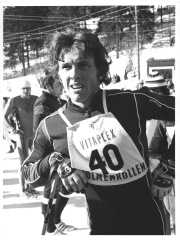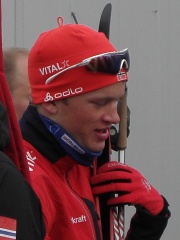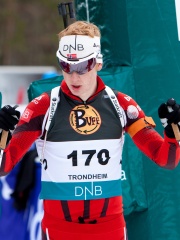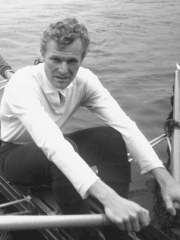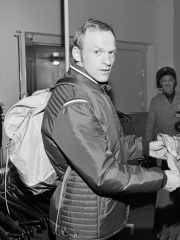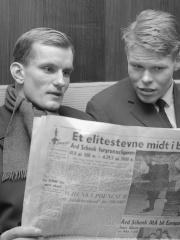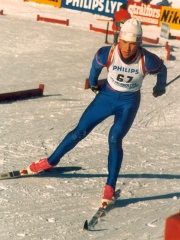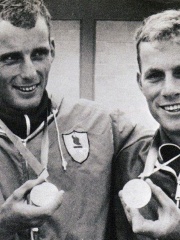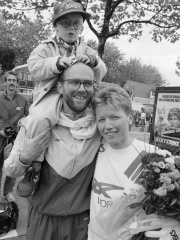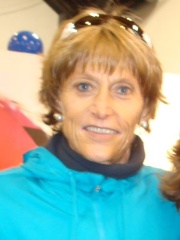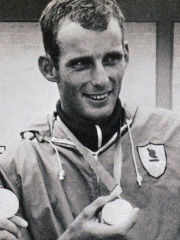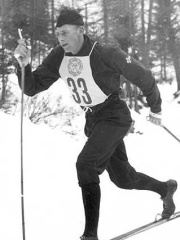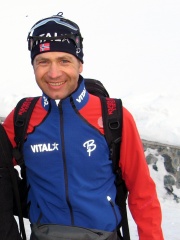
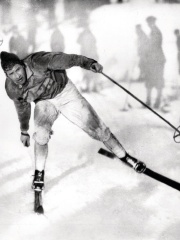
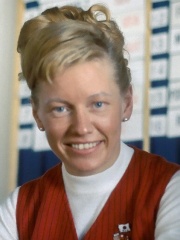
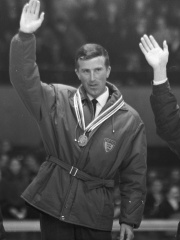
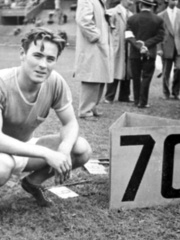
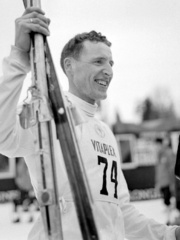
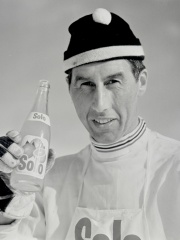
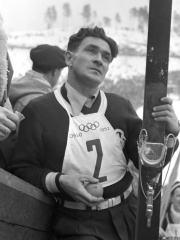
The Most Famous
ATHLETES from Norway
Top 10
The following people are considered by Pantheon to be the top 10 most legendary Norwegian Athletes of all time. This list of famous Norwegian Athletes is sorted by HPI (Historical Popularity Index), a metric that aggregates information on a biography's online popularity. Visit the rankings page to view the entire list of Norwegian Athletes.

1. Ole Einar Bjørndalen (b. 1974)
With an HPI of 63.72, Ole Einar Bjørndalen is the most famous Norwegian Athlete. His biography has been translated into 57 different languages on wikipedia.
Ole Einar Bjørndalen (Norwegian pronunciation: [ˈûːɽə ˈæ̂ɪnɑr ˈbjø̂ːɳˌɖɑːɫn̩]; born 27 January 1974) is a retired Norwegian professional biathlete and coach, often referred to by the nickname, the "King of Biathlon". With 14 Winter Olympic Games medals, he is second on the list of multiple medalists behind Marit Bjørgen who has won 15 medals. He is also the most successful biathlete of all time at the Biathlon World Championships, having won 45 medals. With 95 World Cup wins, Bjørndalen is ranked first all-time for career victories on the Biathlon World Cup tour. He has won the Overall World Cup title six times, in 1997–98, in 2002–03, in 2004–05, in 2005–06, in 2007–08 and in 2008–09. In 1992, he won his first career medal at the junior world championships. A year later in 1993, after winning three junior world championship titles, a medal haul only previously achieved by Sergei Tchepikov, Bjørndalen made his Biathlon World Cup debut. His breakthrough came in 1994 when he featured on his first World Cup podium in a sprint race held in Bad Gastein, Austria. Bjørndalen first competed in the Olympic Games at the Lillehammer 1994 Winter Olympics, held in his home country of Norway. He obtained his first major victory on 11 January 1996 in an individual competition held in Antholz-Anterselva, Italy. On 20 February 2014, Bjørndalen was elected to an eight-year term at the International Olympic Committee's athlete commission. He resigned from this role in 2016 as he elected to continue his career.

2. Johan Grøttumsbråten (1899 - 1983)
With an HPI of 61.31, Johan Grøttumsbråten is the 2nd most famous Norwegian Athlete. His biography has been translated into 24 different languages.
Johan Hagbart Pedersen Grøttumsbraaten (24 February 1899 – 24 January 1983) was a Norwegian skier who competed in Nordic combined and cross-country. Dominating both events in the 1920s and early 1930s, he won several medals in the early Winter Olympics. Most notably, he won two gold medals at the 1928 Winter Olympics, and as one of the only two entrants to win two gold medalists from St. Moritz, was the most successful athlete there, along with Clas Thunberg of Finland. He previously won three medals (one silver, two bronzes) at the inaugural Winter Olympics held in Chamonix in 1924, and went on to defend his Olympic title in Nordic Combined Skiing at the 1932 Winter Olympics. In addition, he won three gold medals at the FIS Nordic World Ski Championships: In 1931 he won both the cross-country 18 km and Nordic combined, after winning the Nordic combined event earlier in 1926. Grøttumsbråten is one of only four people to ever win the Holmenkollen ski festival's Nordic combined event five times (1923, 1926, 1928, 1929 and 1931). In 1924, he shared the Holmenkollen medal with fellow Norwegian Nordic combined athlete Harald Økern.

3. Berit Mørdre (b. 1940)
With an HPI of 60.69, Berit Mørdre is the 3rd most famous Norwegian Athlete. Her biography has been translated into 19 different languages.
Berit Mørdre-Lammedal (née Mørdre, 16 April 1940 – 23 August 2016) was a Norwegian cross-country skier. She competed at the 1968 and 1972 Olympics in the 5 km, 10 km and 3 × 5 km relay events and won a complete set of medals: a gold, a silver and a bronze. She also won a silver medal in the relay at the 1966 World Championships. Mørdre was born and raised on a farm in Nes, but since 1965 lived in Oslo, where she worked as a police officer. In 1969 she married, and changed her last name to Mørdre-Lammedal. She took part in several Holmenkollen ski festivals, winning the 5 km race in 1974. In 1971 she became the first Norwegian woman to win the Holmenkollen medal (shared with Marjatta Kajosmaa and Reidar Hjermstad). Domestically she won 13 Norwegian titles, six over 5 km and seven over 10 km.

4. Magnar Solberg (b. 1937)
With an HPI of 60.55, Magnar Solberg is the 4th most famous Norwegian Athlete. His biography has been translated into 22 different languages.
Magnar Solberg (born 4 February 1937) is a former Norwegian biathlete and police officer. He won a gold medal in the 20 km at the 1968 and 1972 Winter Olympics; his 4 × 7.5 km relay teams placed second in 1968 and fourth in 1972. In 1968 he was awarded Morgenbladets Gullmedalje, and in 1972 served as the Olympic flag bearer for Norway at the opening ceremony. He was one of the 16 former Norwegian athletes selected to bring in the Olympic Flag at the Opening Ceremony of the 1994 Winter Olympics. After retiring from competitions Solberg became a police officer. He was one of the officers responsible for the miscarriage of justice against Fritz Moen, by adjusting a murder victim's time of death in order to dismiss Moen's alibi. He later admitted to wrongdoing, retired from the police force, and worked in the insurance industry.
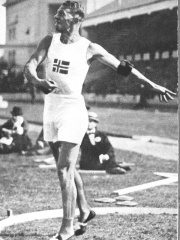
5. Helge Løvland (1890 - 1984)
With an HPI of 60.34, Helge Løvland is the 5th most famous Norwegian Athlete. His biography has been translated into 26 different languages.
Helge Andreas Løvland (11 May 1890 – 26 April 1984) was a Norwegian military officer, track and field athlete, sports official and writer. He won the gold medal in the decathlon at the 1920 Olympics. Løvland was awarded the Egebergs Ærespris in 1919.

6. Egil Danielsen (1933 - 2019)
With an HPI of 59.80, Egil Danielsen is the 6th most famous Norwegian Athlete. His biography has been translated into 26 different languages.
Egil Danielsen (9 November 1933 – 29 July 2019) was a Norwegian javelin thrower. He competed at the 1956 and 1960 Olympics and won the gold medal in 1956. Danielsen, who used an old-type wooden javelin, did poorly in the 1956 final, which was led by his Polish friend Janusz Sidło. Trying to help Danielsen, Sidło lent him his modern steel javelin, and Michel Macquet gave him a cup of strong coffee. Danielsen set a new world record at 85.71 m and won the gold medal. He could never reproduce that throw. For his Olympic victory and world record Danielsen was selected Norwegian Sportsperson of the Year in 1956. Danielsen finished tenth at the 1954 European Championships and won a silver medal in 1958, behind Sidło. He became Norwegian champion in 1953–1957. Danielsen was an avid cross-country skier before changing to javelin throw. He took fencing lessons from a top Norwegian fencer to improve his flexibility, reflexes and the use of right arm. He retired after the 1960 Olympics and focused on his family and work at the Hamar Fire Brigade. In the 2000s he was a minor political candidate for the Norwegian Pensioner Party.

7. Ole Ellefsæter (1939 - 2022)
With an HPI of 59.29, Ole Ellefsæter is the 7th most famous Norwegian Athlete. His biography has been translated into 20 different languages.
Ole Martin Ellefsæter (15 February 1939 – 18 October 2022) was a Norwegian athlete. He mostly competed in cross-country skiing, and won two gold medals at the 1968 Winter Olympics. At the 1966 FIS Nordic World Ski Championships he won one gold (4 × 10 km relay) and one silver (15 km) medal, and in 1971 he became the first Norwegian to win Vasaloppet. Competing in the 3000 metres steeplechase, he won six national championships in a row, from 1960 to 1965. For his accomplishments in both sports, he was awarded Egebergs Ærespris. Ellefsæter also had a singing career, and had two hit songs in Norway.

8. Harald Grønningen (1934 - 2016)
With an HPI of 58.92, Harald Grønningen is the 8th most famous Norwegian Athlete. His biography has been translated into 19 different languages.
Harald Grønningen (9 October 1934 – 26 August 2016) was a Norwegian cross-country skier who competed during the 1960s, earning five winter olympic and two world championship medals. He also won nine Norwegian championship titles and received the King's cup in 1963 and 1967. Grønningen won the 15 km twice (1960 and 1961) at the Holmenkollen ski festival and earned the Holmenkollen medal in 1961. Grønningen was born in Lensvik. He was also an able long-distance runner. His personal best times were 15:03.2 minutes in the 5000 metres, achieved in September 1963 at Trondheim stadion, and 31:04.6 minutes in the 10,000 metres, achieved in September 1961 at the same stadium. He represented the club Lensvik IL.

9. Simon Slåttvik (1917 - 2001)
With an HPI of 58.46, Simon Slåttvik is the 9th most famous Norwegian Athlete. His biography has been translated into 19 different languages.
Simon Kaurin Slåttvik (24 July 1917 – 7 May 2001) was a Norwegian skier. He competed at the 1952 Winter Olympics in the Nordic combined and 18 km cross-country skiing and won the gold medal in the former event. Earlier he won a Nordic combined bronze medal at the 1950 World Championships. He won 14 Norwegian titles and was the first Nordic combined athlete to jump over 100 m. Slåttvik won the Nordic combined event at the Holmenkollen ski festival in 1948, 1950 and 1951, and was awarded the Holmenkollen medal in 1951. Slåttvik started competing in Nordic events aged 15. His career was delayed by World War II and peaked around 1950, when he was already in his thirties. After the 1952 Olympics he won a national title in 1953, placed fifth at the 1954 World Championships, and remained active through the late 1950s. Slåttvik was known for his relatively mild training regime, and would often smoke after a race. In the early 1950s he moved to Lillehammer, married and had two sons. He named one of them Heikki after his Finnish friend and long-term rival Heikki Hasu.
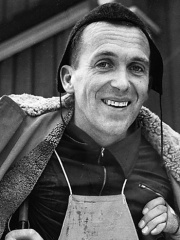
10. Hallgeir Brenden (1929 - 2007)
With an HPI of 58.23, Hallgeir Brenden is the 10th most famous Norwegian Athlete. His biography has been translated into 19 different languages.
Hallgeir Brenden (10 February 1929 – 21 September 2007) was a Norwegian cross-country skier and steeplechase runner. He competed in various skiing events at the 1952, 1956 and 1960 Winter Olympics and won two individual gold medals in 1952 and 1956 and two silver medals in the 4 × 10 km relay in 1952 and 1960. He also won three events at the Holmenkollen ski festival: 18 km in 1952 and 15 km in 1956 and 1963. He received the Egebergs Ærespris in 1952 and the Holmenkollen medal in 1955. As a steeplechase runner Brenden won the Norwegian championships in 1953 and 1954.
People
Pantheon has 162 people classified as Norwegian athletes born between 1866 and 2003. Of these 162, 132 (81.48%) of them are still alive today. The most famous living Norwegian athletes include Ole Einar Bjørndalen, Magnar Solberg, and Tom Sandberg. The most famous deceased Norwegian athletes include Johan Grøttumsbråten, Berit Mørdre, and Helge Løvland. As of April 2024, 26 new Norwegian athletes have been added to Pantheon including Lars Bjønness, Per Sætersdal, and Sverre Løken.
Living Norwegian Athletes
Go to all RankingsOle Einar Bjørndalen
1974 - Present
HPI: 63.72
Magnar Solberg
1937 - Present
HPI: 60.55
Tom Sandberg
1955 - Present
HPI: 56.44
Tarjei Bø
1988 - Present
HPI: 55.79
Johannes Thingnes Bø
1993 - Present
HPI: 55.29
Frank Hansen
1945 - Present
HPI: 55.01
Pål Tyldum
1942 - Present
HPI: 54.90
Trine Hattestad
1966 - Present
HPI: 54.83
Per Ivar Moe
1944 - Present
HPI: 54.78
Eirik Kvalfoss
1959 - Present
HPI: 54.71
Jan Johansen
1944 - Present
HPI: 54.59
Ingrid Kristiansen
1956 - Present
HPI: 54.16
Deceased Norwegian Athletes
Go to all RankingsJohan Grøttumsbråten
1899 - 1983
HPI: 61.31
Berit Mørdre
1940 - Present
HPI: 60.69
Helge Løvland
1890 - 1984
HPI: 60.34
Egil Danielsen
1933 - 2019
HPI: 59.80
Ole Ellefsæter
1939 - 2022
HPI: 59.29
Harald Grønningen
1934 - 2016
HPI: 58.92
Simon Slåttvik
1917 - 2001
HPI: 58.46
Hallgeir Brenden
1929 - 2007
HPI: 58.23
Grete Waitz
1953 - 2011
HPI: 58.05
Steinar Amundsen
1945 - 2022
HPI: 57.95
Sverre Stenersen
1926 - 2005
HPI: 57.11
Hakon Barfod
1926 - 2013
HPI: 56.61
Newly Added Norwegian Athletes (2025)
Go to all RankingsLars Bjønness
1963 - Present
HPI: 48.40
Per Sætersdal
1964 - Present
HPI: 44.81
Sverre Løken
1960 - Present
HPI: 44.46
Dag Bjørndalen
1970 - Present
HPI: 44.28
Bent Ånund Ramsfjell
1967 - Present
HPI: 43.96
Gry Østvik
1963 - Present
HPI: 43.51
Elin Kristiansen
1968 - Present
HPI: 43.08
Tore Torvbråten
1968 - Present
HPI: 42.16
Anthon Grimsmo
1968 - Present
HPI: 40.72
Kjetil Undset
1970 - Present
HPI: 40.50
Liv Kjersti Bergman
1979 - Present
HPI: 40.22
Annette Sikveland
1972 - Present
HPI: 40.19
Overlapping Lives
Which Athletes were alive at the same time? This visualization shows the lifespans of the 25 most globally memorable Athletes since 1700.

